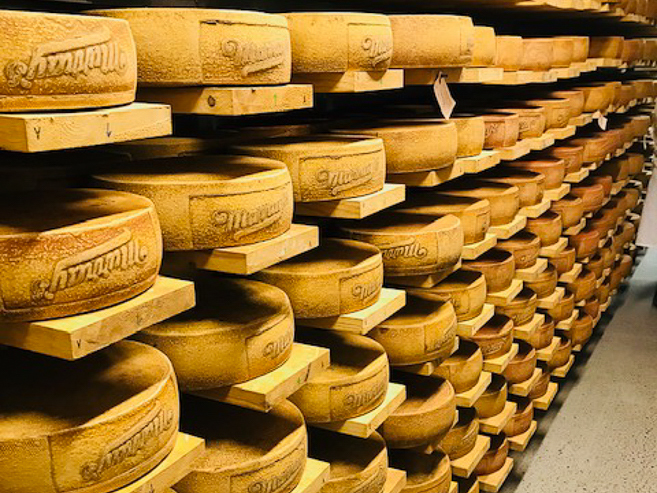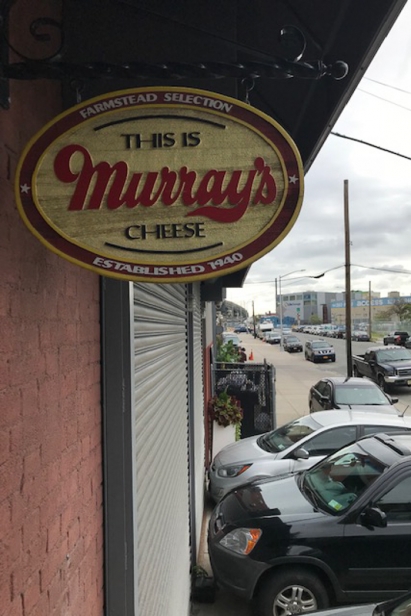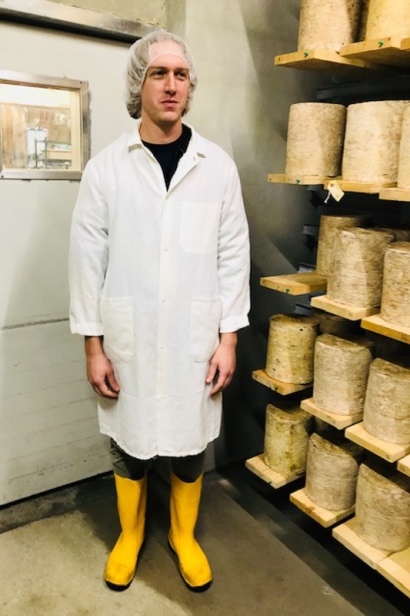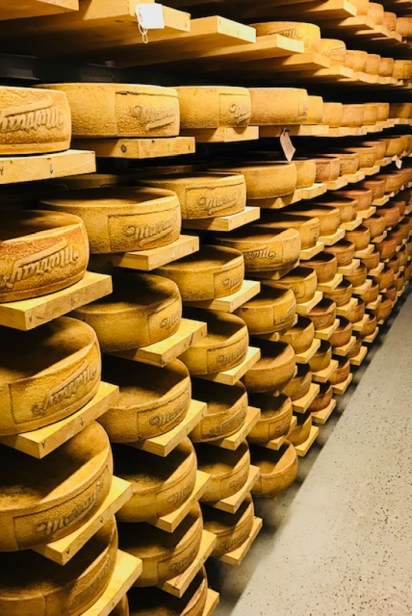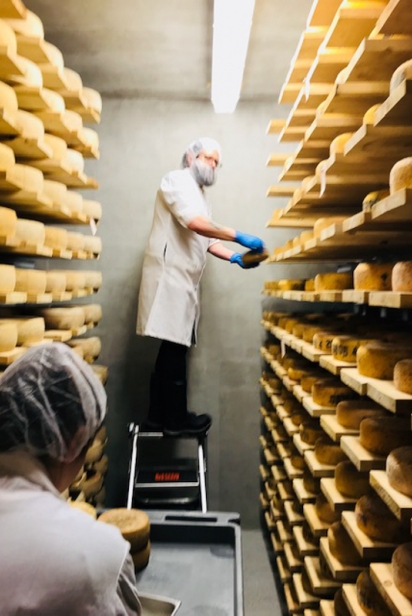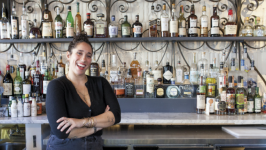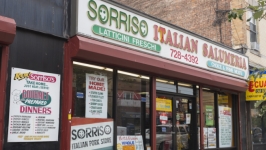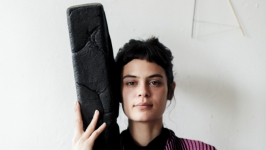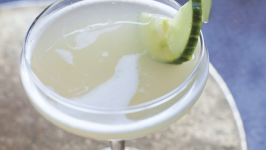Inside Long Island City's Cheese Caves
On a visit to Murray's cheese caves, no spelunking equipment is required
In a crayon-scribbled children’s book inherited from my older sister a few decades ago, there’s a picture of a little girl running barefoot with a couple of goats on a green hill in Switzerland.
In the story, the little girl named Heidi has come to live with her grandfather in a spartan log cabin high in the Alps, where he welcomes her with a bowl of goat milk, bread and cheese: simple food for simple folk, born of what he could make with his own hands and the milk from his herds on the mountain.
Years and miles removed from Heidi’s Alps, the alchemy that Heidi’s grandfather practiced on his mountain continues in a modest warehouse in Long Island City. Here, Peter Jenkelunas, cavemaster for the iconic, Greenwich Village–based Murray’s Cheese, presides over the ages-old craft of affinage (cheese ripening) in thoroughly modern surroundings.
Murray’s was the first cheese retailer in the country to establish its own aging facility, beginning with a 600-square-foot cheese cave on Manhattan’s Bleecker Street in 2004. In 2013, Murray’s moved its aging facilities to its distribution center in Long Island City, doubling the size of its cheese caves to 1,200 square feet. With demand for artisanal cheeses growing, it was a practical move for the company, founded in 1940 by Eastern European immigrant Murray Greenberg. The distribution facility had the space to expand, and it made sense to move the caves closer to the area where orders are filled and shipped.
Situated in a brick building in a workaday section of Borden Avenue, the exterior of Murray’s gives only a hint of the riches inside. A modest, sideways oval sign above the glass door proclaims proudly, “This is Murray’s Cheese.”
Beyond its matter-of-fact exterior lies a clean, well-lit place; one that Murray’s is proud to show off. Because educating the public about cheese is an outsized part of Murray’s mission, the company regularly offers cave tours to the general public.
Once a month, a small band of urban adventurers heads into the heart of Queens for a morning or afternoon of caving under the expert guidance of one of Murray’s cavemasters.
This kind of caving requires no ropes, flashlights or helmets, although wearing one of those puffy, operating-room-style hairnets is required (But not to worry: The arduousness of the expedition can be gauged by the fact that Murray’s begins their tours by treating guests to a round of mimosas). It also doesn’t require descending into the basement. The caves are all located on the main floor.
Once visitors have donned the hairnets, lab coats and boots required to keep stray microbes from hitching a ride into the caves, it’s off to the inner sanctum to learn how bacteria, mold, cold, time, humidity and technique transform cow, goat and sheep’s milk into cheesy magnificence.
If you’ve ever left a hunk of cheese in the back of your fridge for an extended period of time, you’ve seen how nature can swiftly turn that once-tasty wedge of fat and protein into a science project gone rogue. And despite its ancient origins as a simple method of preserving milk, science is what modern cheesemaking is all about.
Over the years, the cavemasters at Murray’s have worked with Cornell University’s food science laboratories and artisanal farms in New York and Vermont to create unique cheeses and curate their development.
“People are surprised how much work goes into it,” Jenkelunas says. “There’s a lot of labor involved.”
It’s the research and development process that Jenkelunas enjoys most about his work, and there’s science in every step. Jenkelunas, who earned bachelor’s and master’s degrees in food science from the University of Massachusetts at Amherst and the University of British Columbia, was instrumental in the development of Stockinghall Cheddar, the first artisanal cheese Murray’s created.
His team experimented for over a year before achieving success with a crumbly, fudgy cheddar with bacon, sour cream and pineapple flavors. “We went up to Cornell University, picked up the cultures and came up with it ourselves,” Jenkelunas says proudly.
Another cheese he takes a lot of pride in is the Lait Bloomer, a Brie-style cheese coated in flowers, giving it a singular flavor. “We tried two dozen different flowers,” Jenkelunas said, before they found what they were looking for with a blend of calendula, elderflower and helichrysum.
Once, many cheeses were aged in actual caves that provided a natural climate for preservation. Today’s cheese caves are carefully controlled, high-tech environments that look more like walk-in refrigerators.
In Murray’s Washed Rind cave, “stinky” cheeses thrive on warm temperatures and high humidity, creating a bacterial party that culminates in a pungency passionate turophiles seek.
On my visit to the caves, Assistant Manager Krista Jacobsen and her colleague, Josh Windsor, were busy taking individual cheeses down from their shelves one by one for their weekly baths.
“Do you have to like cheese to work here?” I asked them.
“You don’t have to, but you should,” Jacobsen said. “Besides,” added Windsor, “who doesn’t like cheese?”
As we move from cave to cave, I’m surprised to find that they don’t smell of cheese. Instead, there’s an earthy, grassy, occasionally acrid aroma generated by the cheese coatings and the action of unseen microbes on the cheeses themselves.
Cheesemakers are patient; they have to be, because slow aging is often the key to making good cheese great. Murray’s Cheeses are to Velveeta what Chateneuf du Pape is to box wine. Sure, there’s a place for Velveeta and box wine (dorm dinner, anyone?) but it’s definitely not here.
So let us go then, into the Bloomy Rind Cave, where goat cheeses all the way from the Loire Valley in France slowly age from the outside in as the days tick by, eventually developing an off-white, brainy surface that reminds me a little of a jelly doughnut. Unlike a jelly doughnut, however, these cheeses will bunk in this Bloomysphere for three to five weeks before developing the creamline between rind and body that signals it’s ready to eat. If you’ve ever had the misfortune to discover mold in your basement—or, worse, in your shower—you’ll probably find it difficult to think of mold as a friendly visitor. But when it comes to cheese, mold is pretty much the life of the party.
Fans of soft-ripening cheeses like Brie and Camembert might consider adding the mold Penicillium candidum to their holiday thank you list. It’s responsible for creating the snowy exterior that signals when it’s time for your Brie to check out of the Bloomy Rind hotel.
“They come in inoculated; the mold is in there and we provide the environment for it to grow,” says Jenkelunas.
Things are a little more—say, continental, in the Natural Rind Cave, where cheeses like Murray’s Stockinghall are left to absorb molds from the surrounding environment, developing a mottled, multi-colored appearance. Like tourists transformed by a summer in Paris, cheeses like Murray’s Stockinghall become far more sophisticated after a few months hanging around the Natural Rind cave. High humidity in this cave keeps the rinds alive while colder temperatures provide the slow aging this cheese requires.
It’s the Alpine Cave that might have reminded a grown-up Heidi of home. Here, traditional wheels of Annelise cheese ranging in weight from 10 to 200 pounds are stacked on high shelves like summer camp bunkmates. Each wheel is branded with the Murray’s logo. It’s the number one photo op for tour takers, according to Murray’s PR manager, Mindi Sachs.
These wheels of Annelise hail from Heidi country, where they’re made by second-generation cheesemaker Walter Rass in the Appenzell valley of Northern Switzerland. As in centuries past, many farmers in this region still celebrate the end of another green season by welcoming their cows and goats down from the high Alps for the winter with songs and parades, decorating their animals with colorful garlands of flowers and ribbons.
Heidi and her grandfather knew cheese to be a gift of nature. It’s edible poetry; a part of the whole of every living thing. It speaks of place and time, of earth and flower; of animal and mineral, grass and sky.
As a tour through Murray’s cheese caves amply illustrates, it takes randomness and intention, tradition and science, commitment and plain hard work to turn this simple gift into treasure.


